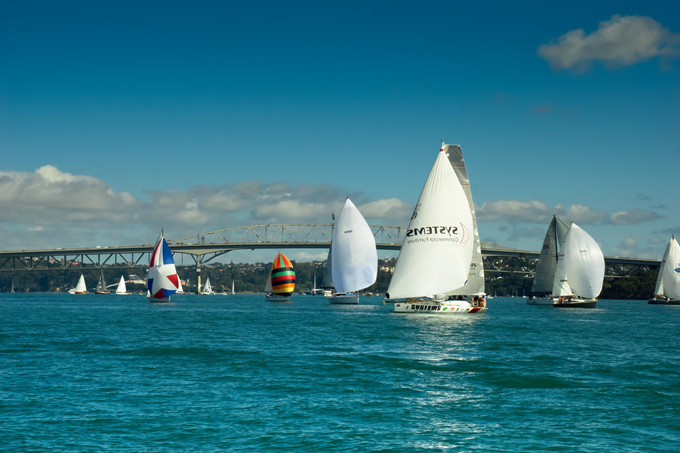From Hauraki Gulf Forum Co-Chairs Toby Adams and Nicola MacDonald.
Sounds technical? It is. But it’s important.
Traditionally in New Zealand when infrastructure fails, we would price the repair and replacement, and potentially the inconvenience, but then shrug our shoulders when it comes to pricing any associated impacts around natural capital.
That traditional approach leads to two poor outcomes. First, we end up under-valuing the natural environment. Second, we end up under-investing in resilient local infrastructure.
On 27 September this year, a sinkhole opened-up in the Gulf-side Auckland suburb of Parnell. Attributed in part to climate impacts from storms earlier in 2023, the rupture of the sewer resulted in untreated wastewater flowing into the Waitematā harbour at a rate of hundreds of litres per second. Surrounding beaches were immediately black flagged, with no swim/no fish recommendations in place. It would be a month, and hundreds of millions of litres discharged, before the overflow was fully brought under control.
Earlier this year, the Forum released the first Natural Capital Valuation of the Hauraki Gulf Marine Park. Undertaken by the New Zealand Institute of Economic Research (NZIER), the valuation showed that the Gulf was worth upwards of $100 billion to New Zealand, and provided annual flows of value to New Zealanders in excess of $5bn per year.
The Parnell sinkhole is the first test case for the model’s ability to price specific events. Helped by some reasonably clear metrics, such as the area effected and number of days no swim/no fish recommendations were in place, NZIER was able to quantify – within broad parameters – the effects of the sinkhole event on the ecosystem services provided by the Gulf. In addition, for the period of the sinkhole, the Gulf was effectively providing wastewater treatment services that would otherwise have been provided on land.
The net result? The impact on ecosystem services ranges between $50.9 million and $166.6 million for the duration of the sinkhole event, or between $1.02 million to $3.33 million per day.
This is a conservative figure. It recognizes that the area in question was only part of the Gulf, it does not price impacts on mauri, and it assumes no lingering impacts. But it helps put into context the fact for this event the natural capital impacts were significant. It also shows that impacts on natural capital goods and services should form part of cost-benefit analyses for infrastructure investment.
To be clear, the attached report is no criticism of Watercare. On the contrary, their teams worked day and night to get it fixed, and they acted with haste on the day of the sinkhole to communicate the public health implications. And just yesterday their executives attended and briefed a Forum meeting to share everything that has been learned so far. This was appreciated.
What the report is, is an example of how natural capital accounting can help provide a much fuller picture of the impact of failing infrastructure. In addition, the report builds the case for sustained and serious investment in quality local three-water infrastructure that is resilient to climate and other impacts now and into the future.
The health of the Gulf, and our enjoyment of it, depends on it.
What is the Hauraki Gulf Marine Park?
The Hauraki Gulf Marine Park is New Zealand’s first marine park.
It’s a big park, stretching from Te Arai in the north to Waihi in the south, and out to 12 nautical miles at sea.
At 1.4 million hectares, or more than 20 times the size of Lake Taupō, it includes the Waitematā Harbour, Gulf Islands, Firth of Thames and the east coast of the Coromandel Peninsula.
The Park was established by the Hauraki Gulf Marine Park Act in February 2000.
It is the seabird capital of the world, and a whale superhighway. But it is a shadow of its former self, as six State of the Gulf reports have shown: https://gulfjournal.org.nz/state-of-the-gulf/
What is the Hauraki Gulf Forum?
The Hauraki Gulf Forum is a statutory governance board established under the Marine Park Act to advocate for the Gulf.
The Forum has representation on behalf of the tangata whenua of the Hauraki Gulf and its islands, the Ministers of Conservation, Oceans & Fisheries and Māori Development, and elected representatives from Auckland Council (including Aotea Great Barrier Island and Waiheke Island Local Boards), Waikato Regional Council, and the Waikato, Hauraki, Thames-Coromandel and Matamata-Piako District Councils.
The Forum is required to present triennial reports regarding the state of the environment of the Hauraki Gulf Marine Park. It is not a decision-making body and does not manage the Gulf. More information on the Forum and the Marine Park is available at www.gulfjournal.org.nz



